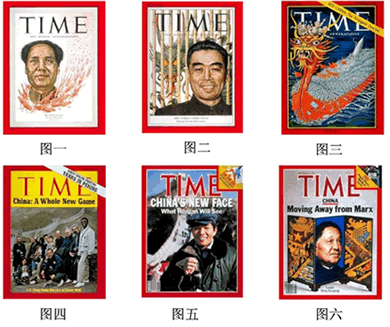以下是美国《时代》周刊所选用的一些中国封面人物,体现了美国社会对中国的关注。阅读材料并回答问题。

图一是1950年12月11日的期刊,人物是毛 * * 。标题是:RED CHINA’S MAO(红色中国的毛)。背景为红色基调的蝗虫。
图二是1954年3月10日期刊,人物是周恩来。标题是:RED CHINA’S CHOU EN—LAI(红色中国的周恩来)。
图三是1963年9月13日的封面,标题是:RED CHINA:The Arrogant Outcast(红色中国,狂妄的被孤立者)。船头上的四个人物是毛 * * ,刘 * * ,周恩来和邓 * * 。一艘过分拥挤的大船,船舷上摞着补丁,船上热闹非凡,标语上写着打倒赫鲁晓夫,打倒资本主义;斯大林,列宁和赫鲁晓夫的画像被抬出来示众,船尾是中国的导弹,有人在上面以武力示威。
图四是1971年4月26日的期刊,封面上是美国乒乓球运动员在长城的合影。
图五是1984年4月30日的期刊,表现的是一个普通的中国人手里拿着可口可乐,面露微笑。
图六是1985年9月23日的期刊,画面以邓 * * 图像为中心,一边是游行的队伍高举着马克思的画像,农民在田里插秧;另一边是忙忙碌碌的上班族、高楼大厦、汉堡包、照相机等。标题下面的小字是:“Moving Away from Marx”。
请回答:
(1)结合图一中的背景(红色基调的蝗虫)说明当时的中美关系的状态。
____________________________________________________________________________________
____________________________________________________________________________________
(2)举出图二中人物在新中国成立后至50年代中期的外交活动两例。
____________________________________________________________________________________
____________________________________________________________________________________
(3)结合图片三分析当时中国的外交形势。
____________________________________________________________________________________
(4)说明图片四反映的历史事件的特定称谓。70年代我国外交重大突破与转机的关键是什么?。
____________________________________________________________________________________
(5)图五反映了当时中国怎样的对外政策。图六邓 * * 图像两边的内容对比表达了什么含义?图片中的题目Moving Away From Marx的中文意思是什么?你是否赞同这一观点并说明理由。
____________________________________________________________________________________
____________________________________________________________________________________
____________________________________________________________________________________
____________________________________________________________________________________
(1)当时美国对社会主义国家采取冷战敌对政策,视社会主义为赤色祸水。中美关系处于敌对状态。
(2)同印度代表团会谈时提出“和平共处五项原则”,率代表团第一次以五大常任理事国之地位参加日内瓦国际会议,参加了万隆会议。
(3)外交环境恶化,中美关系敌对紧张,中苏关系破裂。
(4)乒乓外交。中美关系缓和。
(5)图五表明中国实行对外开放的政策。 图六邓 * * 图像两边的内容是对改革开放前后不同时代的生活进行对比,意在说明中国开放的现代化成效。题目Moving Away From Marx的意思是中国正在远离马克思。这种说法不合理。马克思主义不意味着封闭落后,中国特色的社会主义是符合中国国情的发展了的马克思主义。
